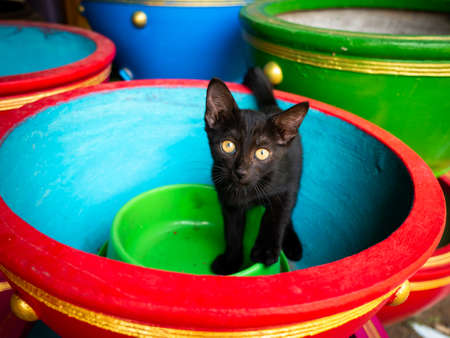Understanding Your Cat’s Play Behavior
If you’ve ever caught your cat batting at a pen or diving into an empty cardboard box, you’re not alone. Cats are naturally curious creatures, and everyday household items can seem like exciting toys to them. But why are cats so attracted to things like hair ties, paper bags, or laundry baskets?
Why Are Cats Drawn to Household Items?
Cats have strong hunting instincts. Even if your kitty has never set paw outside, their wild ancestors relied on chasing, pouncing, and catching prey. Many common household items mimic the movement or texture of small animals, triggering your cat’s playful side. For example:
| Household Item | What It Mimics | Why Cats Love It |
|---|---|---|
| Paper bags | Rustling leaves or hidden spaces | Perfect for hiding and ambushing—like stalking prey! |
| Hair ties | Small wriggling prey | Easy to bat around and carry in their mouth |
| Boxes | Safe dens or nests | Cats love squeezing into small spaces to feel secure and observe their surroundings. |
| Pens and pencils | Moving insects or lizards | The rolling motion encourages chasing and pouncing. |
The Benefits of Play for Cats
Play isn’t just fun for your cat—it’s vital for their health. Here’s how it helps:
- Physical Exercise: Chasing and jumping keeps your cat active, helping them maintain a healthy weight.
- Mental Stimulation: Figuring out how to “catch” a moving object exercises their brain and prevents boredom.
- Stress Relief: Play is a natural way for cats to burn off energy and reduce anxiety—especially in multi-cat homes or indoor environments.
- Bonds with Humans: Interactive play strengthens the connection between you and your feline friend.
Real-Life Example: How Felix Finds Fun in the Ordinary
Susan from Ohio noticed her tabby, Felix, was obsessed with plastic bottle caps. Whenever she dropped one, Felix would zoom across the kitchen floor in hot pursuit. Not only did this give Felix great exercise, but Susan realized it also kept him entertained when she was busy. However, she soon learned that some household items aren’t always safe for play—which we’ll cover in the next section.
Safe Household Items Cats Can Play With
Curious cats love to explore, and sometimes they find the most fun in everyday items lying around your home. While not every object is safe, there are several household items that can provide hours of entertainment for your feline friend—if you use them wisely. Here’s a list of common objects that are generally safe for cats, along with tips on how to supervise and use them safely.
Everyday Objects Safe for Cat Play
| Item | How to Use Safely |
|---|---|
| Cardboard Boxes | Remove any staples, tape, or loose pieces. Let your cat jump in and out, but check for chewing and replace if soggy or damaged. |
| Paper Bags (No Handles) | Cut off handles to prevent choking or entanglement. Supervise play to make sure your cat doesnt eat pieces of the bag. |
| Toilet Paper Rolls | Offer the empty rolls for batting and tossing, but pick up chewed pieces to avoid ingestion. |
| Socks (Clean) | Tie a knot in an old sock to create a soft toy. Remove if threads start coming loose. |
| Plastic Bottle Caps (No Sharp Edges) | Rinse caps thoroughly and watch for sharp edges. Remove if cracked or damaged during play. |
| Ice Cubes | Let your cat bat ice cubes around a slick floor for a fun chase. Always supervise to prevent slipping accidents. |
Supervision Tips for Safe Play
- Watch Closely: Even safe items can become dangerous if broken or chewed into small pieces.
- Avoid Small Parts: Never let your cat play with anything small enough to swallow or choke on.
- Check Regularly: Inspect toys before each play session. Replace anything that shows wear or damage.
- No Strings Attached: Avoid giving cats yarn, ribbons, or strings from household items as these can cause serious digestive problems if swallowed.
- Cats Are Individuals: Some cats chew more than others. If yours is a chewer, be extra cautious about what you allow during playtime.
Real-Life Example: Paper Bag Hide-and-Seek
Maggie, a Maine Coon living in Ohio, loves hiding in paper grocery bags. Her owner always snips off the handles and supervises while Maggie dives in and out, making sure she doesn’t chew on the paper too much. When Maggie gets too excited and starts tearing the bag, her owner replaces it right away—simple steps that keep playtime both safe and fun!
![]()
3. Dangerous Household Items You Should Avoid
While it might seem harmless to let your cat bat around whatever they find at home, some everyday objects can actually be dangerous. Let’s break down which household items you should keep away from your curious kitty, why theyre risky, and real-life examples of what can go wrong.
Common Household Hazards for Cats
| Item | Risk Type | Real-Life Example |
|---|---|---|
| Rubber Bands & Hair Ties | Choking/Intestinal Blockage | A Michigan family spent $1,200 in vet bills after their cat swallowed a hair tie and needed surgery to remove it. |
| String, Yarn, Dental Floss | Choking/Digestive Injury | A Texas cat almost died after ingesting dental floss that got tangled in its intestines. |
| Plastic Bags | Suffocation/Choking | A pet owner in California shared how her cat got stuck inside a plastic grocery bag and nearly suffocated before being rescued. |
| Lilies (and other toxic plants) | Toxicity (Kidney Failure) | A New York veterinarian warned of multiple cases where cats suffered kidney failure after chewing on lily leaves or petals. |
| Small Toys (Legos, Beads, etc.) | Choking/Obstruction | An Illinois couple’s kitten had emergency surgery after swallowing a Lego piece left on the living room floor. |
| Human Medications (like Tylenol) | Toxicity/Poisoning | A Florida rescue shared the story of a cat who nearly died after licking an acetaminophen pill dropped on the carpet. |
| Paper Clips & Pins | Mouth/Throat Injury | A cat in Oregon required stitches after playing with a paper clip and puncturing its mouth. |
| Cords & Electrical Wires | Electrocution/Injury | A Georgia pet parent reported burns on her kitten’s mouth after it chewed through a phone charger cord. |
| Aluminum Foil & Food Wrappers | DIGESTIVE BLOCKAGE/Toxicity (if chocolate is present) | An Ohio vet treated a cat with severe digestive issues after it ate a candy wrapper that still had chocolate residue inside. |
Why Are These Items So Dangerous?
- Cats explore with their mouths: Many cats love to chew or swallow small objects when playing, increasing choking and blockage risks.
- Toxic substances: Some items contain chemicals or materials that are poisonous to felines, even in small amounts.
- Easily overlooked: Everyday items like rubber bands or pills are easy to drop and forget about—but very tempting for curious cats.
What Can You Do?
- Store small items securely: Keep hair ties, rubber bands, medications, and toys out of your cat’s reach—use drawers or closed containers.
- Cord management: Use cord protectors or hide wires behind furniture to prevent chewing accidents.
- No-go zones for plants: If you love houseplants, double-check which ones are safe for cats and keep toxic varieties out of your home.
If You Suspect Your Cat Has Swallowed Something Dangerous…
If your cat is vomiting, coughing, pawing at their mouth, acting lethargic, or refusing food, contact your veterinarian right away. Quick action can save your furry friend’s life!
4. Signs Your Cat Might Be in Trouble
Even if you do your best to keep unsafe household items away from your cat, accidents can still happen. It’s important to know how to spot the warning signs that your cat may have gotten into something they shouldn’t have. Recognizing these signals early can make a big difference for your cat’s health and safety.
Common Behavioral Warning Signs
Cats are masters at hiding discomfort, so pay close attention to any changes in their normal behavior. Here are some red flags:
| Behavioral Sign | What It Could Mean |
|---|---|
| Sudden hiding or avoiding family members | Your cat might be feeling scared or unwell after a scary or painful experience with an object. |
| Unusual vocalization (crying, yowling) | Pain, distress, or physical injury caused by chewing or swallowing something unsafe. |
| Lethargy or lack of interest in play | Your cat could be feeling sick after ingesting something toxic or sharp. |
| Restlessness or pacing | Your cat may be uncomfortable due to a foreign object stuck in their mouth, throat, or digestive tract. |
| Frequent pawing at the mouth or face | This often signals irritation, choking, or something stuck between their teeth. |
Physical Symptoms to Watch For
Sometimes the warning signs are more physical than behavioral. Look out for:
- Vomiting or retching: Could indicate poisoning, blockages, or ingestion of foreign objects.
- Coughing, gagging, or difficulty breathing: May mean your cat has inhaled or swallowed something dangerous like string or small toy parts.
- Drooling excessively: This is often a response to toxic substances, irritation, or choking hazards.
- Swelling around the mouth, nose, or paws: Might point to allergic reactions from plants or chemicals your cat played with.
- Bleeding from the mouth or gums: Can result from biting hard objects like plastic, glass, or metal.
- Trouble walking or sudden weakness: May signal exposure to chemicals (like cleaning products) that can affect nerves and muscles.
If You Notice Any of These Signs…
If you spot any of these symptoms after your cat has been exploring household items, don’t wait—contact your vet right away. Quick action can prevent serious complications and help keep your furry friend safe.
5. Setting Up a Cat-Friendly Play Environment
Creating a fun and safe play area for your cat doesn’t have to be complicated or expensive. By combining everyday household items with cat-specific toys, you can keep your feline entertained and out of trouble. Here’s how you can set up a space that encourages healthy play while minimizing risks.
Use Safe Household Items
Not every object lying around your house is safe for your cat, but some common items can become great toys if you use them wisely. For example, cardboard boxes are classic favorites—cats love to hide, jump in, and scratch at them. Paper bags (without handles) also make crinkly, fun hideouts. Just remember to avoid anything sharp, small enough to swallow, or with loose strings.
Examples of Safe Household Items for Play
| Household Item | How to Use It |
|---|---|
| Cardboard boxes | Create tunnels or forts by cutting holes; stack for climbing fun |
| Paper towel rolls | Let your cat bat them around or stuff with treats for DIY puzzles |
| Paper bags (handles removed) | Place on the floor for hiding and pouncing games |
| Socks (clean) | Tie a knot and toss for your cat to chase or wrestle with |
Add Cat-Specific Toys and Furniture
To keep things interesting and safe, mix in a few toys made especially for cats. Scratching posts, interactive wands, and puzzle feeders are designed with your pet’s safety in mind. Cat trees or shelves give indoor cats places to climb and survey their kingdom without getting into forbidden areas.
Must-Have Cat Items for Enrichment
- Scratching posts: Protects furniture and satisfies natural instincts
- Interactive wand toys: Great for bonding time and exercise
- Puzzle feeders: Stimulates your cat’s mind during snack time
- Catnip mice or balls: Encourages independent play when you’re busy
- Window perches: Lets your cat safely watch birds and squirrels outside
Create Dedicated Play Zones
If possible, pick a corner or room where your cat feels comfortable. Lay down an easy-to-clean rug, set up scratching posts, and rotate toys regularly to keep things fresh. Avoid placing fragile decorations or toxic plants within reach. If you have kids at home, teach them which items are meant for the cat so everyone stays safe.
Quick Tips for Success
- Rotate toys weekly to prevent boredom—stash away a few and swap them out often.
- Always supervise when introducing new household items to ensure they’re truly safe.
- If something gets chewed up or starts falling apart, replace it right away.
- Add vertical spaces like shelves or cat trees to satisfy climbing urges.
- Keep cleaning supplies, rubber bands, and other hazards locked away from curious paws.
A thoughtful mix of safe household objects and quality cat products will help keep your kitty happy, active, and out of trouble—making playtime enjoyable for everyone!
6. When to Seek Vet Help
Even if you try your best to keep your cat safe, accidents can happen—especially if they get into household items that aren’t meant for play. Knowing when you need to call the vet right away can make all the difference for your kitty’s health and safety. Here’s how to recognize situations where immediate veterinary care is needed after risky play or exposure:
Common Emergency Scenarios
| Situation | What to Look For | Why Call the Vet? |
|---|---|---|
| Chemical Exposure (cleaners, detergents, etc.) | Drooling, pawing at mouth, vomiting, difficulty breathing, burns around mouth or skin | Chemicals can be toxic and cause life-threatening reactions fast. |
| Choking or Swallowing Small Items (rubber bands, hair ties, string) | Coughing, gagging, pawing at mouth, sudden distress, loss of appetite, vomiting | Foreign objects can block airways or digestive tract—needs urgent help. |
| Electrical Cord Bites | Burns on lips/tongue, drooling, trouble breathing, collapse | Electric shock can cause serious internal injuries and even stop the heart. |
| Plastic Bag Play | Panting, hiding, blue gums/tongue, struggling to breathe | Bags can cause suffocation very quickly. |
| Toxic Plant Chewing (lilies, poinsettia, etc.) | Vomiting, diarrhea, drooling, lethargy, tremors or seizures | Many common plants are highly poisonous to cats. |
What to Do If You Notice These Signs
- Stay calm: Your cat will sense your stress. Speak softly and handle them gently.
- Remove the item/exposure source: Take away any remaining object or chemical safely if possible.
- Don’t try home remedies: Don’t force your cat to vomit or give anything by mouth unless told by a vet.
- Contact your vet or an emergency animal hospital: Tell them what happened and follow their instructions right away.
- If possible, bring a sample: If your cat ate something harmful (like a plant or piece of plastic), take a piece with you for identification.
Quick Reference: Red Flag Symptoms Needing Immediate Vet Care
- Trouble breathing or choking sounds
- Uncontrollable vomiting or diarrhea
- Lethargy or collapse
- Seizures or twitching muscles
- Pale or blue gums/tongue
- Sustained bleeding or obvious pain
- Chemical burns on skin/mouth
- Your gut feeling that something is seriously wrong!


